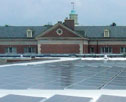In September 2011, at the International Roofing Symposium 2011: Emerging Technologies and Roof System Performance held in Washington, D.C., Rene Dupuis, president of Structural Research Inc., Middleton, Wis., and I presented a paper about research we have been conducting regarding the dryness of newly poured structural concrete roof decks and alternative approaches for evaluating concrete decks' readiness for roofing materials.
Our research may help you if you are involved in new construction roofing projects with concrete roof decks or an existing roofing project with a concrete roof deck where moisture accumulation within the roof system is problematic.
Historical methods
Most roofing professionals have relied on historical, nonscientific methods to determine the dryness levels of concrete roof decks.
For example, one method is to either mop or pour hot bitumen on a concrete deck's surface. If the bitumen doesn't splatter or froth too much, the deck can be considered "dry." In other instances, a clear plastic sheet is taped to a concrete deck's surface and the sheet's underside is observed for condensation. This procedure is defined by ASTM D4263, "Standard Test Method for Indicating Moisture in Concrete by the Plastic Sheet Method." Another method involves no physical testing; concrete roof decks arbitrarily are considered dry 28 days after being poured and finished.
Given current mix designs for concrete and increased use of admixtures, lightweight aggregates, curing compounds and surfacing treatments, Dupuis and I no longer consider the historical methods of determining the relative dryness of concrete roof decks to be adequate.
An alternative approach
During our research, Dupuis and I looked to the flooring industry and found some alternative methods of evaluation.
Concrete Floors and Moisture, Second Edition, written by Howard Kanare, senior principal scientist at CTL Group, Skokie, Ill., discusses several ways to evaluate the necessary dryness of concrete floor slabs before floor covering application. Dupuis and I found one method to be of particular interest and practical for use in evaluating concrete roof deck dryness.
ASTM F2170, "Standard Test Method for Determining Relative Humidity in Concrete Floor Slabs Using in-situ Probes," provides a relatively inexpensive method for determining relative humidities and temperatures within concrete slabs, and these values can be compared with recognized baselines to determine concrete slabs' relative dryness.
The method involves drilling small holes in a concrete slab and placing and sealing small humidity and temperature sensors in the drilled openings. After a defined period where the probe and surrounding concrete reach equilibrium, the concrete's relative humidity and temperature can be measured.
In our research, Dupuis and I conducted limited ASTM F2170 testing and found mean relative humidity values from 89 to 99 percent in existing concrete roof decks covered with membrane roof systems that range from 4 to 7 years old.
Currently, acceptable roof system-specific relative humidity values for concrete roof decks do not exist. However, Kanare reports relative humidity values from 65 to 85 percent typically are considered acceptable in the flooring industry depending on the floor covering being used. Also, though normal-weight structural concrete used for floor slabs may reach acceptable levels in fewer than 90 days, lightweight structural concrete may take about six months to reach equivalent levels.
Additional information
A possible alternative approach for determining when a newly placed concrete deck is suitable to be covered has been identified. However, before the roofing industry can implement this alternative approach, roof system-specific acceptable values for concrete roof decks' relative humidities need to be determined.
If you are involved in projects where ASTM F2170 testing has been conducted, Dupuis and I encourage you to share the test results with us. Also, if you are involved in a project with a concrete roof deck where moisture accumulation in the roof system is a concern, ASTM F2170 testing of the concrete roof deck should be considered.
Our complete research paper, as well as 28 other research papers from the symposium, are available from NRCA by calling (866) ASK-NRCA (275-6722) or accessing shop.nrca.net.
Mark S. Graham is NRCA's associate executive director of technical services.



